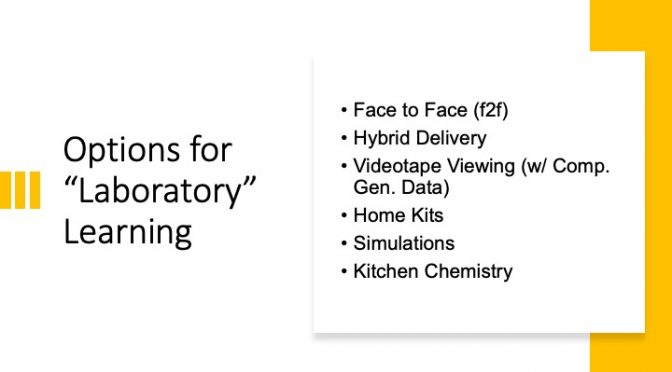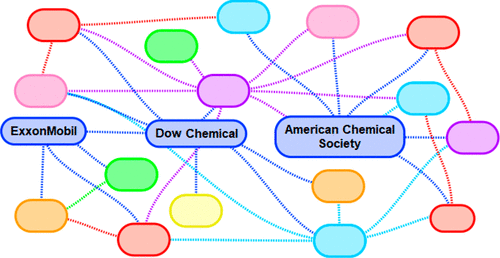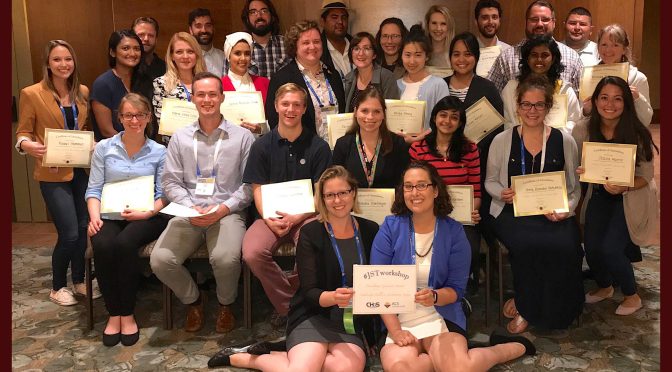Topic: Returning to the Teaching Lab
Date and Time: July 23, 2020 04:00 – 5:00 PM Eastern Time
Led by: Frankie Wood-Black

You view and can download the recording here
CHAS members can review the rough transcript of the session here. Contact Ralph Stuart at membership@dchas.org for the password
Session Chat:
00:23:59 Frankie Wood-Black: Welcome to the CHAS Chat!
00:25:11 Frankie Wood-Black: We will be recording the session. And I will be saving the Chat.
00:25:33 Frankie Wood-Black: That way if you wish to send out links – we can capture them for all.
00:41:47 Samuella Sigmann: We are not using cloth masks in the lab.
00:43:37 Danka Szwajkajzer: The face shields do not give you much of protection.
00:44:18 Abby OConnor: Yes I think we are doing face mask with clear panel + face shield
00:44:36 Ruth Nalliah: What are some ways of dealing with goggle-fogging while using a face mask? Nose guard wires may help, but even the anti-fog goggles tend to fog more with a face mask on, which becomes a safety hazard.
00:45:05 Robin Izzo: We are using disposable masks in labs. Cloth masks everywhere else. Not allowing face shields without a cloth or disposable face mask
00:45:27 Aulaire S.: I’ve heard good things from students about the commercial anti-fog solution that swimmers use on their goggles. I’ve recommended that to the sweatier students in the past.
00:45:38 Samuella Sigmann: Same with us Robin. New disp. mask each meeting.
00:46:41 a0gorc01: We are using cloth masks, and we are using half the # students, and we put plastic shields on the lab benches between students.
00:46:52 Samuella Sigmann: We are forming our Student Learning Outcomes and basing what we do on them.
00:47:41 Chris Hermann: Radford University will provide student a disposable mask and gloves for each lab. We will have half the students in each lab – 10 instead of 24. In organic chem, each student has their own hood to use instead of sharing a hood.
00:47:59 Clara Rosalía Alvarez Chavez: We will use disposable masks in labs and suggest cloth masks in other places too
00:49:02 Pamela Auburn: I have elevators to deal with
00:49:03 Robin Izzo: Some guidance on fogging (second and third questions in the FAQ) https://ehs.princeton.edu/EHSCovidFAQs#FaceCoverings
00:49:40 LaKeisha McClary: Thanks for the resource, Robin!
00:50:03 a0gorc01: We are going to have a few online substitutions for students who are quarantined, but we are debating how many labs can be done like this
00:50:15 mei sun: most face shields cover eyes so it is acceptable to have students wearing cloth masks and face shield, no goggles so no fogging?
00:51:04 LaKeisha McClary: Our general chem and ochem labs each have at least one virtual lab section, so students who cannot return to campus or who are quarantined can engage with the course
00:51:29 Nick Spurr: what is red/gray schedule
00:51:53 klubertanztm: Face shields are not splash goggles so it depends on the lab.
00:52:05 LaKeisha McClary: red/gray = descriptor for the week a student will attend lab f2f
00:53:12 Jing-Yi: what if a student is tested positive in the middle of the semester? do we need to have all the students quarantined?
00:53:25 Denise Beautreau: @Mei sun face shield does not provide the same eye protection as goggles do in a chemistry lab and should not replace wearing goggles
00:53:25 Chris Hermann: RU is testing students, but not faculty or staff. Two face masks are being issued to every student, faculty and staff.
00:54:03 a0gorc01: We’re not coming back after Thanksgiving
00:54:10 klubertanztm: Our chemistry department is providing the masks 100% cotton and they stay in the student’s lab drawers.
00:54:22 Abby OConnor: Yes it seems a lot of small schools are not testing faculty and staff. Same at many places
00:54:31 Chris Hermann: We start August 12 and end finals before Thanksgiving.
00:54:34 Frankie Wood-Black: Red/gray – is like an A/B – half one week – half the next
00:55:41 Jennifer Jensen: Here at Central College students, staff, and faculty are being provided with 2 face masks and one face shield. All courses have been moved to rooms where social distancing can be followed for instruction. Most labs are moving to cohorts that rotate between working in the lab and remote learning. We’re looking at disposable masks for the chemistry labs so students don’t wear masks that are potentially contaminated with chemicals back to their dorm room or other places on campus.
00:55:56 Jennifer Chaytor: Thoughts on safety of masks in organic lab? Some concerns are solvent vapors and flammability.
00:56:10 J. Sheridan: From a different chat. Clear face masks mentioned. https://www.theclearmask.com/
00:56:50 JGile: That’s a good idea Sammye- thank you. I’ll put that to my department.
00:57:12 Kendra Denlinger: Would you have to disinfect everything if it didn’t get used again for over a month? Just wondering!
00:57:38 Pamela Auburn: we are going to individual set ups also
00:57:38 klubertanztm: We are using 100% cotton tight weave. Before this there was nothing covering the face, so I think of it as one more layer to take off if they are on fire.
00:57:43 Aulaire S.: At Indiana University, we are requiring students to bring the cloth (cotton) masks to the labs, and stocking disposable masks to hand out to students if they do get chemicals or solvents on their masks.
00:58:00 elisabethclark: How are you managing lab coats?
00:58:17 Chris Hermann: Organic students will have glassware in their hood that lives in the hood, such as beakers, erlenmeyers, graduated cylinders. They each have their own Kemkit and drawer.
00:58:28 JGile: For those of you using cotton masks for chemistry labs, how are you testing them for chemical exposure?
00:58:58 Elisa.Woolridge: What’s best practice for a lab-compatible disinfectant? Our institution is providing a peroxide-based product, but we’re thinking of a 70% v/v ethanol or isopropanol solution.
00:59:00 Ximena Da Silva Tavares: Does anyone have a protocol for chemical spills on the masks? Thoughts on safety shower vs eye stations?
00:59:24 a0gorc01: We wear gloves in the organic labs
00:59:34 Christine Wood: Is it really necessary to sanitize lockers between semesters if the virus would be inactive on objects within a few days? It seems to me that the semester break would be plenty of time.
00:59:59 beary: We are having bio students to wipe down their space before they leave.
00:59:59 Caroline McNeil: Our university is requiring instructors clean between every class.
01:00:03 Aulaire S.: We’re going to be soaking the glassware after each section. The University is supplying spray bottles of sanitizer and asking students to spray down their space after their done. And the rooms are supposed to be heavily cleaned each night by the custodial staff.
01:00:19 JGile: @Ximena: For us, chemical spill on a mask = remove and bag / tag that mask. Put on a new mask. I don’t understand your question on safety showers and eyewash stations.
01:00:54 beary: How effective are the UV lights? Is there a duration time from being effective?
01:00:57 Ludivina Avila: Ethanol can increase the permittivity of skin to chemicals?
01:00:57 Samuella Sigmann: I am not sure if time would solve the cleaning between the semester issue.
01:01:04 Chris Hermann: No sharing of goggles. Students must provide their own.
01:01:38 Ximena Da Silva Tavares: Sorry, meant if the spill happens while the student is wearing mask (not that they would put on a mask after spill)
01:01:40 JGile: @beary http://www.bioline.org.br/pdf?mb08074
01:01:56 Aulaire S.: We’re not assigning lockers because we’re afraid that the university will shut down in the middle of the semester, and we found that it takes weeks to clean out those lockers if the students will have to suddenly leave again.
01:02:41 Abby OConnor: Has any one been teaching summer class labs f2f yet? Experience?
01:02:44 klubertanztm: incase of contaminated mask it needs to be easily removable and then use emergency eyewash or shower.
01:03:06 JGile: @Ximena, depends on the spill and the location. I would personally treat the mask like any clothing and remove it to flush the area. If the spill is on the hand, the hand can be flushed in a sink without removing the mask.
01:03:54 Ximena Da Silva Tavares: Sounds reasonable thanks, just wanted to hear what other people’s thoughts on this was.
01:04:44 Ludivina Avila: UV does damage the RNA of the virus but duration depends on porosity of the material being treated and the intensity of the UV source.
01:05:20 Ruth Nalliah: The UV wavelength also matters (250 nm best)
01:05:35 Brian D’Amico: Grainger has the Bulwark FR masks in stock.
01:06:00 Ludivina Avila: Mercury lamps create UV that is damaging human eyes and skin so be careful there too.
01:06:00 Jim Roberts: And don’t forget the nobody should be able to see or be exposed to any UV.
01:07:17 Elisa.Woolridge: Using what as a disinfectant?
01:07:27 Caroline McNeil: That is very lucky! I’m lucky to have someone take out the trash from the lab…
01:07:38 Ludivina Avila: There is a list (list N) from the EPA
01:07:59 Renae Z’Berg: how about shared computers in the lab? Thoughts
01:08:02 Melissa Anderson: How long are people estimating for lab-turnaround (i.e. time to disinfect)? Our labs are full from 7 a.m. to 10 p.m. so turnaround time will be a major factor in how many sections we can offer.
01:08:05 Aulaire S.: https://www.epa.gov/pesticide-registration/list-n-disinfectants-use-against-sars-cov-2-covid-19
01:08:14 Lara Milane: Please wear a mask as faculty – we have to set the example. And disinfection/life of virus depends on the surface. The virus also aerosols. Please read: https://www.nejm.org/doi/full/10.1056/NEJMc2004973
01:08:34 rhanson46: Needs to be UV-C
01:09:04 Teal Atkinson: And goggle cabinets need 15 minutes
01:09:27 Lara Milane: UV is not very effective at all – any film or particles on the bulb prevents penetration.
01:09:40 Monique R Wilhelm: I am pushing for q one hour turnaround between my labs because they are rather large spaces.
01:09:56 Jim Roberts: And then you must turn the rocks over….
01:10:11 Renae Z’Berg: 10 min contact time for our disinfectant VIrex
01:10:16 Ludivina Avila: longer wavelength UV can penetrate 350nm or so
01:10:35 Ludivina Avila: Mercury lamps create a few wavelengths in the UVC region
01:10:37 JGile: We’re using non-microwavable plastic wrap on top of the computer keyboards.
01:10:43 Chris Hermann: Shared keyboards will have something like Saran wrap. The students will be using gloves in the labs.
01:11:02 Aulaire S.: We found shower cap-like keyboard covers, and they seem to work well and are easy to wipe off. Still haven’t figured anything out for the mice, though.
01:11:06 Jocelyn Nadeau: For those providing new disposable masks to students for lab, what will your procedure be for donning/doffing them safely to minimize unmasked faces in the lab? We are also providing new masks, but we are grappling with how to go about the mask changes.
01:11:22 Pamela Auburn: where did you find those
01:11:44 J. Sheridan: We are thinking kim wipes as a protective barrier between user and knob, dial etc. on electronic equipment such as balances and hot plates
01:12:04 JGile: @J Sheridan, I think kim wipes are pretty porous.
01:12:06 Ludivina Avila: many of the disinfectants recommend on the list are quartenary ammonia based (ethanol and peroxide too)
01:12:18 Elisa.Woolridge: We (Marist Chemistry) are familiar with EPA’s List N, but we want to make sure the disinfectant is compatible with our equipment, etc., and not leave a residue.
01:12:33 Kathy Wall: a little spray bottle of denatured alcohol works too
01:12:34 Ruth Nalliah: Disinfecting wipes are sometimes hard to get ahold of (high demand, low supply)
01:14:02 Ludivina Avila: low residue think pure ethanol/propanol I would think.
01:14:52 Ludivina Avila: Some water in it actually makes it more effective
01:14:58 Gary Johnson: FDU, northern NJ (Teaneck/Hackensack): 1st 3 weeks, all virtual; live if the State is open; have to do a self check for symptoms daily (students and staff); plans for labs (sizes? A/B?) not yet announced; starting early (aug 17), finish semester by Thanksgiving. Summer has been all virtual, mostly “Beyond Labz”
01:15:05 a0gorc01: I have 25 sections of organic labs. I’m worried about having to go completely online from the start or early on. Anyone know of any good online organic labs? I’ve only seen videos of people doing the labs. I’ve worked with Labflow as an alternative for some labs, but it’s not good for all labs.
01:15:38 Samuella Sigmann: Great poll
01:15:50 Aulaire S.: Here’s the example of the keyboard covers I mentioned: http://www.viziflex.com/disposables/universal-disposable-50-pack/
01:16:25 Abby OConnor: NC state has great online resources for organic labs
01:16:36 Abby OConnor: For organic labs there are lots of resources for online labs
01:16:42 Rachel Campbell: How are you going to handle students who show up without goggles and if you are on a two week rotation and don’t have shared backup goggles?
01:16:53 Amber Charlebois: I have been making my own videos for my organic lab. I am just finishing up orgo 2 on line lab. I have made 27 videos and would be happy to share. acharle5@naz.edu
01:17:13 Ludivina Avila: has anyone thought about HEPA filtration units to help with the aerosols?
01:17:31 Deborah Lee: @a)gorc01 – NCSU virtual labs, Beyond Labz, and many faculty have lab videos such as Laura Starkey and Jane Wissinger’s youtube pages
01:17:46 Gary Johnson: Don’t due organic myself, but Beyond Labz does have a number of organic labs. (I am not shilling, just my experience) – you can download, it works in live mode for 2 or 5 days. Cost is $25 per license.
01:17:58 klubertanztm: So they will be using that as a changing room? Won’t that concentrate their breath and aerosols?
01:18:32 Ximena Da Silva Tavares: @a0gorc01: merlot.org is a good place to go looking. There was an ACS seminar yesterday 7/22 that was recorded and will be posted where people gave lists of resources (haven’t look at all yet).
01:19:29 Aulaire S.: If students don’t come with goggles or a mask, they have ~10-20 minutes to go get one and come back. Otherwise they won’t be allowed in. If they refuse to wear a mask in any class, they will be asked to leave or the class will end (this is the official IU policy for the entire university).
01:19:36 Jim Roberts: HEPA filtering – many building can NOT be equipped with HEPA filters due to increased resistance to air flow — the result is lower air flow in occupied spaces. Your building may be different…….
01:19:40 Kendra Denlinger: I just watched that webinar today, it was good!
01:20:20 Aylen Wargniez: Are you planning to monitor students’ temperature before entering the lab?
01:21:24 Tomas Berger: Teens and twenty somethings often do not run fevers. Measuring temps is mostly a placebo for us
01:21:25 Frankie Wood-Black: We aren’t going to monitor temperature.
01:21:31 Ludivina Avila: Whole building HEPA is more than what I was think maybe a couple HEPA filters in the corners to help eliminate unsettled particulates.
01:22:53 Jim Roberts: Localized HEPA filter — you must also be careful about location and not disturbing the airflow in the room. In many chemistry labs, the corners are “relatively dead” in terms of airflow.
01:23:29 Wanlu Li: Is there any guideline after someone in the lab has been test positive for COVID?
01:23:30 Monique R Wilhelm: Social distancing ? What are others’ planning for faculty when they do need to get closer to a student in order to help adjust their setup, etc?
01:24:04 Robin Izzo: rmizzo@princeton.edu is my email address.
01:25:15 Caroline McNeil: My son went to the dentist last week and his temp was 101 because of just being in the hot car on the way to the dentist. So we are having students and faculty self-report every morning (campus-wide)
01:26:14 Aulaire S.: IU is planning on quarantining the rooms the students was in for deep cleaning, and then the students next to them in their classes would need to self-isolate and get tested.
01:26:27 Abby OConnor: Also at College of New Jersey (Trenton area) we are doing a self reporting form every day for student and faculty and staff
01:27:48 beary: We have quarantine rooms set up on campus where students will go if they need quarantine. Are local Health dept will test students and do contact tracing if exposure occurs on campus .
01:27:49 LaKeisha McClary: Can you repeat the name of the FB group again?
01:28:04 Teal Atkinson: Johns Hopkins has a free contact tracing course that tells you how to handle cases and contacts.
01:28:10 Wendy Hom: Is this the right facebook group mentioned? https://www.facebook.com/groups/849427775469472/
01:28:26 JGile: @Wendy, yes
01:28:30 Frankie Wood-Black: Strategies for teaching chemistry online
01:28:48 LaKeisha McClary: Thank you Frankie, Wendy, and JGile
01:28:56 JGile: Approval (in my experience) is quite quick.
01:29:14 emejeri: The facebook group is called Strategies for teaching chemistry online
01:29:35 Lorilee Valientes: Approval was almost instant and the FB group is extremely helpful.
01:29:39 J. Sheridan: Would whole lab need shut down if a student was positive for COVID? test results usually delayed by days so is any ‘deep cleaning’ after a positive test necessary?
01:30:08 Robin Izzo: It depends on the situation.
01:30:14 Jennifer Chaytor: @Monique Good question. I’m going to try to limit it, but hopefully if we are both wearing masks (and possibly face shields over top), a few moments closer than six feet won’t be a bit deal. If it is just adjusting, I will ask the students to step away.
01:30:30 Wendy Hom: Thank you @JGile
01:30:43 rhanson46: Thank you.
01:30:45 Clara Rosalía Alvarez Chavez: Thank you for the link to Facebook group, I have sent my request to be admitted
01:30:59 Wendy Hom: We have been recording all the labs meant for the lab including the in-person labs in case we shut down.
01:31:35 Wendy Hom: I am not sure if our department decided what to do for those students that have to be quarantined for two weeks but an option could be to use our pre-recorded labs so that students can still complete them since we will not be having makeup labs.
01:32:46 JGile: @Denise, totally!!!!!
01:32:52 Jodi Wesemann: We are actually hearing people talk about risks, even in the news!
01:33:00 Brian D’Amico: Definitely agree with the need to keep the “normal” safety at the front of mind while we are focused on providing COVID safety.
01:33:02 Amber Charlebois: How can we have access to the recording of this amazing session?
01:33:13 LaKeisha McClary: Yes I love that PPE is a mainstream acronym
01:33:38 a0gorc01: Do you allow students to use phones or computers in labs?
01:34:14 Deborah Lee: I have students use their own phone, laptop, or tablet as my lab is paperless. We use electronic notebooks (ELN)
01:34:19 Jennifer Jensen: Agree Robin. We are taking the approach of being proactive about disinfecting.
01:34:29 Robert Alumbaugh: We find goggles fog up unacceptably with mask use. Anyone know of a good anti-fog coating that can be applied?
01:34:57 Lara Milane: Thank you for hosting! Good luck to all and stay safe!
01:35:21 Wendy Hom: We are going to have students clean before and after using the lab bench. Does anyone have a protocol they would recommend? I was thinking lysol if needed to clean off dirty/grime. And then primarily using 70% ethanol at the start of lab and then 10% bleach at the end of lab.
01:36:05 Shailendra Singh: Thanks for hosting this session. If anyone have any question or need additional information for CMU Pandemic Safety officer training, feel free to email me at shailen2@andrew.cmu.edu





